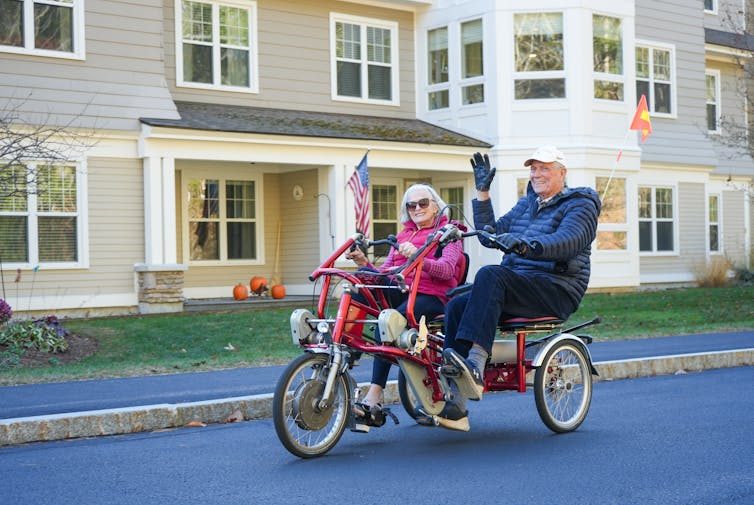Lifestyle
Cycling can make seniors healthier and more independent − here’s how to design bikes and networks that meet their needs
Seniors are increasingly interested in cycling. Research identifies senior-friendly bike designs and infrastructure improvement needs to enhance physical activity and independence among older adults.
Last Updated on December 1, 2024 by Daily News Staff
Most senior citizens get around in their daily lives by driving, walking or using public buses and subways. But many people in their 60s and 70s could potentially be interested in other options, such as cycling. At a time when cycling is growing in the U.S. and the overall population is aging, seniors’ preferences for bike designs and bike networks are very relevant.
Older people may have concerns about riding a two-wheeled bike if they are afraid of falling – a risk that increases with age and causes many seniors to become less active. Many cities and communities are working to create safer bike networks, but these are designed for young, physically fit bikers, who are less afraid to bike near cars and don’t need an occasional bathroom break.
Some seniors live in assisted living complexes or memory care facilities that have roads, sidewalks and paths for residents pushing walkers. However, these complexes don’t usually have bike storage rooms, bike loops or safe bike pathways to local parks and stores.
I am a researcher in architecture – with a focus on environment and behavior – and a senior, and I have studied bikes and bike networks for over 43 years. In my latest project, I worked with Seth Gale, a behavioral neurologist; Linda Mazie, a health and wellness coach who works with seniors; and Heidi Savage, a fitness director who also works with seniors, to learn from older people what kinds of bicycles and bike networks would help them stay active and independent through cycling. https://www.youtube.com/embed/vrrzFnzYUXI?wmode=transparent&start=0 In the Netherlands, where many people of all ages routinely ride bikes, local officials take a tour with older riders to identify spots that seniors find particularly unsafe on their route.
We found that a majority of the seniors whom we surveyed and who test-rode three bikes preferred a three-wheeled adult tricycle or a two-seat model that lets riders sit side by side. For infrastructure, their key requirements included bike loops, separation from cars and nearby bathrooms.
Benefits of biking for seniors
Many older people in the U.S. don’t get enough physical activity for healthy aging. A 2016 study by the Centers for Disease Control and Prevention found that more than one-fourth of all adults over 50 did not engage in any physical activity outside of work. This share increased with age and was higher among people with chronic diseases such as cancer, diabetes and depression. Inactivity was significantly higher among women than men, and among Black and Hispanic seniors compared with white seniors.
Biking provides many health benefits, including cardiovascular exercise, stronger muscles, better coordination and lower stress levels. It also offers benefits that are particularly relevant for seniors. For example, one study found that cycling for at least one hour per week significantly improved older people’s balance, potentially making them less vulnerable to falls.
There also are findings suggesting that exercise may help slow the progression of Alzheimer’s disease. For example, one study showed that when mice exercised on a wheel, their muscles produced irisin, a hormone that supports cognitive function. The irisin passed into their brain, improving memory and spatial awareness.
Senior-friendly bikes
For our study, we distributed surveys with pictures of senior-friendly bikes and questions about bike networks to 178 seniors in four senior communities in Massachusetts and New Hampshire. Participants ranked the pictures according to how well they liked the various bike designs and offered more comments while seeing the pictures on a large screen.
We also borrowed three senior-friendly bikes made by Van Raam, a Dutch company that designs bikes for a wide range of special needs. These models included:
- A three-wheeled bike for side-by-side riders who each have handlebars and who can pedal together while one steers.
- An adult tricycle with a back rest and low center of gravity.
- A two-wheeled bike with a low center bar that makes it easy to step through when getting on or off.
Fifty seniors at RiverWoods-Exeter, a senior living complex in New Hampshire, and Fox Hill Village, an independent living community for seniors in Westwood, Massachusetts, were invited to test-ride the three models and complete a survey about their experiences.
Designing bike networks for older riders
Based on photos, participants were most enthusiastic about the adult tricycle and also were interested in the two-seat three-wheeler. Adult tricycles are harder to pedal than bikes with two wheels, and rounding corners involves turning the handlebars without leaning, so these models have a learning curve. However, they offer stability, which clearly was important to the people in our study.
Among seniors who did test rides, the most popular model was the single-seat three-wheeled bike. Unlike a low recumbent bicycle, this bike’s seat is about as high as a chair, and unlike an adult tricycle, it has a back rest.
Participants’ second choice was the three-wheeled two-seater bike, which has seats with backs, arm rests and seat belts. Fewer participants were willing to test-ride the two-wheeled regular bike with a low center bar; those who tried it were already comfortable riding two-wheeled bikes.
Comments were enthusiastic, especially for the two-seater bike. Seniors wrote, “I like the social aspect and teamwork”; “I see this as an asset to our community”; and, simply, “Awesome!!!”
Some noted that the two-seater could work for seniors who were caregivers for their spouses. One husband wrote, “This would be great to ride with my wife, who hasn’t ridden a bike for 50 years.”
In response to survey questions about the most important features of a senior-friendly bike network, participants said they wanted to be able to bike for 30 minutes at a stretch, ride twice a week and have a bathroom available.
For a network added to their assisted living complexes, they wanted a cycling loop on-site; a route to a destination outside the complex; a smooth, flat riding surface with grass shoulders; and picnic tables and water nearby. Participants felt that cars traveled too fast in their residential complexes, so they wanted to ride on separated paths rather than on existing roads.
Our findings echo other studies that have shown that senior cyclists want to ride in protected bike lanes or separate paved paths, rather than in street traffic. Because many seniors have limited vision, another feature that can make bike paths safer for them is light-colored demarcation strips at the edges of the path to help older riders avoid veering off the main cycle path, especially at night.
Pedaling ahead
Here are the key steps that I believe would be required to develop findings like ours into scalable bicycling programs for seniors in the U.S.
Some seniors might appreciate having classes to relearn how to ride a two-wheeled bike, or to ride with another person on a two-seater model. Assisted living complexes could install bike storage sheds and buy several senior-friendly bikes for residents to ride.
Protected bike lanes could be made more senior-friendly by building them level with the adjoining sidewalk, so that a third wheel could rest on the edge of the parallel sidewalk. Lanes optimized for senior riders would be continuous and have bicycle traffic signals, raised crosswalks and nearby public bathrooms with signs leading to them.
Routes could run from residential neighborhoods to destinations such as coffee shops, post offices, grocery and drugstores, and parks. Destinations could provide space to park and lock the bikes while riders shopped or had coffee.
The U.S. has an aging population, and seniors’ health is an important concern for seniors themselves, their caregivers and taxpayers. There is strong evidence that increased bicycle use by seniors could help many people live healthier and more independent lives well into their golden years.
Anne Lusk, Lecturer in Urban Agriculture, Boston University
This article is republished from The Conversation under a Creative Commons license. Read the original article.
Our Lifestyle section on STM Daily News is a hub of inspiration and practical information, offering a range of articles that touch on various aspects of daily life. From tips on family finances to guides for maintaining health and wellness, we strive to empower our readers with knowledge and resources to enhance their lifestyles. Whether you’re seeking outdoor activity ideas, fashion trends, or travel recommendations, our lifestyle section has got you covered. Visit us today at https://stmdailynews.com/category/lifestyle/ and embark on a journey of discovery and self-improvement.
Discover more from Daily News
Subscribe to get the latest posts sent to your email.
Food and Beverage
Unwrap the Holidays: Whataburger Launches 12 Days of Whatacheer With Daily App Deals
Celebrate the holidays with Whataburger’s 12 Days of Whatacheer! Discover daily in-app deals, exclusive to Rewards members, from December 12–23. Unwrap new menu favorites, BOGO offers, and festive savings—only on the Whataburger App.
12 Days of Whatacheer: Festive Deals for Rewards Members
How It Works
- Who: Whataburger Rewards members (sign up in the app if you’re not already!)
- When: December 12–23, with a new offer every day
- How: Open the Whataburger App, claim the day’s deal, and enjoy with your next order
Holiday-themed graphic reading ‘12 Days of WhataCheer’ on a red background with white dots. Below the text are images of Whataburger menu items: a Cinnamon Roll, Onion Rings, a Whataburger, a Whatafresher, a Honey Butter Chicken Biscuit, and a Strawberry Shake.
Why Join the Whataburger Rewards Fun?
Get Started
Discover more from Daily News
Subscribe to get the latest posts sent to your email.
Recipe of the Week
Holiday Desserts Just Got a Dairy-Forward Upgrade
Holiday Desserts: From festive cookies to indulgent dips, these delicious desserts bring people together to create memories that will last a lifetime. If you’re looking to impress guests, Santa Cookies are the ultimate treat. For a unique twist, try Gingerbread Dip, featuring vanilla Greek yogurt made with 100% grass-fed organic milk.
Last Updated on December 17, 2025 by Rod Washington

Holiday Desserts Just Got a Dairy-Forward Upgrade
(Family Features) Holiday desserts set the stage for seasonal delight and add a touch of joy to gatherings. From festive cookies to indulgent dips, these delicious desserts bring people together to create memories that will last a lifetime. If you’re looking to impress guests, Santa Cookies are the ultimate treat. Made with Maple Hill Salted Butter, they’re rich, soft and full of festive spirit. For a unique twist, try Gingerbread Dip, featuring vanilla Greek yogurt made with 100% grass-fed organic milk. Whether you’re hosting or deciding what to bring to the potluck, Maple Hill’s 100% grass-fed organic dairy makes it easy to whip up desserts that are as wholesome as they are delicious. Rich in nutrients and free from GMOs, hormones and antibiotics, each product comes from farms that prioritize regenerative practices as nature intended. With a 40% healthier ratio of omega 3:6 and 40% higher levels of CLA fatty acids compared to traditional organic dairy, you can feel good about sweet treats at the holiday table. To find more recipes, visit MapleHill.com.
Santa Cookies
Yield: 14 cookies- 1 cup (2 sticks) Maple Hill Salted Butter, at room temperature
- 1/2 cup brown sugar
- 1 tablespoon vanilla extract
- 1 large egg, at room temperature
- 2 1/4 cups all-purpose flour
- 1/4 teaspoon salt
- 1 teaspoon red food coloring
- mini chocolate chips
- mini red chocolate-coated candies
- 1/2 cup (1 stick) Maple Hill Salted Butter, at room temperature
- 4 ounces cream cheese, at room temperature
- 1 teaspoon vanilla extract
- 2 1/2 cups powdered sugar
- Preheat oven to 350 F and line two baking sheets with parchment paper.
- In large mixing bowl, beat butter, sugar and vanilla until light and fluffy. Add egg and beat until combined. Add flour and salt; mix until dough begins to form ball.
- Remove 1 cup dough and set aside. Add red food coloring to remaining dough.
- From red cookie dough, make one 1-inch ball and five 1/2-inch balls. From plain cookie dough, make one 3/4-inch ball and five 1/4-inch balls.
- On prepared baking sheet, place red 1-inch ball and gently flatten until 1/2-inch thick. Attach four red 1/2-inch balls for arms and legs. Attach plain 3/4-inch ball for head and gently flatten until 1/2-inch thick. Attach plain 1/4-inch balls for hands and feet. Shape remaining red 1/2-inch ball into triangle for hat and attach. Repeat with remaining dough, arranging cookies 2 inches apart on baking sheet. Add chocolate candies for eyes and buttons.
- Bake 12-15 minutes, or until lightly golden.
- To make frosting: In medium bowl, beat butter and cream cheese until light and fluffy, about 3 minutes. Add vanilla and powdered sugar; mix until combined.
- To decorate: Place half of frosting in piping bag with small tip to line Santa’s arms and legs. Place other half in second piping bag with small star tip to add Santa’s beard, hat and hands. Put small dot of icing between eyes and beard and place red mini chocolate-coated candy on face for nose.

Gingerbread Dip
Servings: 8-12- 4 ounces cream cheese, at room temperature
- 1/4 cup brown sugar
- 1/4 cup powdered sugar
- 3 tablespoons molasses
- 1 container (16 ounces) Maple Hill Vanilla Greek Yogurt
- 1 teaspoon ground ginger
- 1 teaspoon ground cinnamon
- 1 teaspoon ground nutmeg
- 2 cups whipped cream
- graham crackers
- fruit
- In medium bowl using electric mixer on medium speed, beat cream cheese and sugars about 1 minute. Add molasses and mix until combined.
- Add Greek yogurt, ginger, cinnamon and nutmeg; beat until combined. Fold in whipped cream and mix until fully incorporated. Refrigerate 1 hour before serving or overnight.
- Serve with graham crackers and fruit.
At our core, we at STM Daily News, strive to keep you informed and inspired with the freshest content on all things food and beverage. From mouthwatering recipes to intriguing articles, we’re here to satisfy your appetite for culinary knowledge.
Visit our Food & Drink section to get the latest on Foodie News and recipes, offering a delightful blend of culinary inspiration and gastronomic trends to elevate your dining experience. https://stmdailynews.com/food-and-drink/
Discover more from Daily News
Subscribe to get the latest posts sent to your email.
Family
Festive Blooms: How to Use Popular Christmas Flowers
Christmas Flowers: Whether you’re decorating your space with a wreath or garland, giving a fresh gift or crafting the centerpiece for your holiday table, these festive blooms can bring a touch of nature’s joy to your celebrations and showcase the beauty that thrives even during the coldest season.

Festive Blooms: How to Use Popular Christmas Flowers
Whether you’re decorating your space with a wreath or garland, giving a fresh gift or crafting the centerpiece for your holiday table, these festive blooms can bring a touch of nature’s joy to your celebrations and showcase the beauty that thrives even during the coldest season. Poinsettias One of, if not the most iconic, flowers of the holiday season, poinsettias are recognized by their bright red “blooms,” which are actually colorful bracts surrounding small yellow flowers. A symbol of love, hope and Christmas cheer, poinsettias thrive indoors with bright, indirect light and can be used for holiday decor, festive centerpieces or given as a potted gift. Amaryllis Popular for creating holiday arrangements or as a long-lasting indoor plant, the amaryllis features large, trumpet-shaped flowers in shades of red, white, pink or striped varieties. Grown from a bulb, they bloom year after year with proper care, including during the winter months. Holly Featuring glossy green leaves and bright red berries, holly has been a holiday staple for centuries. The flowers are commonly used in wreaths, garlands and other Christmas arrangements and can be displayed on mantels, doors or around doorways. However, holly berries are toxic if ingested, so keep arrangements away from children and pets. Christmas Rose (Hellebore) With blooms that typically appear around Christmas, the Christmas rose is a perennial that thrives in shaded garden beds, even in cooler weather. It brightens up winter landscapes with its creamy white or pink-tinted flowers, which have come to symbolize hope amid the snow. Paperwhites Ideal for tabletop decor or window displays, paperwhites, a type of narcissus, produce clusters of delicate white blooms with a sweet fragrance. They’re easy to grow from bulbs indoors during the winter months and can add a natural holiday touch to any room by simply placing in decorative containers filled with pebbles and water. Learn more about Christmas flowers and find additional seasonal advice at eLivingtoday.com. Photo courtesy of ShutterstockThe fate of Lucky Supermarkets in SoCalLink: https://stmdailynews.com/the-fate-of-lucky-supermarkets-in-socal/
Discover more from Daily News
Subscribe to get the latest posts sent to your email.


